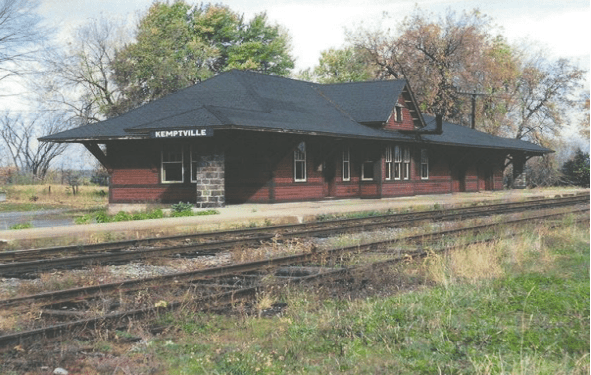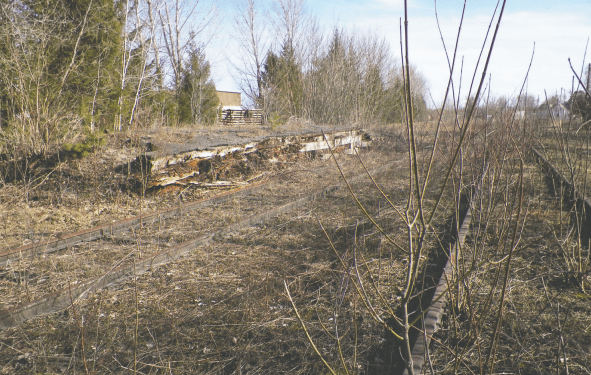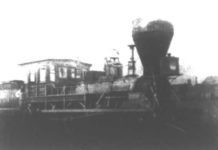Once the business leaders of Oxford-on-Rideau had invested in the Bytown & Prescott Railway Company, work on the line could be brought to a successful conclusion. In 1851, as the first sod was turned in Bytown for the railway terminus there, it was Kemptville resident, Robert Bell, who did the honours. That celebration was led by the Sons of Temperance society. The arrival of the first train into Kemptville Station in August, 1854, was a more jovial occasion, as one correspondent reported:
“The whole town turned out and assembled in front of Adam’s Hotel – the White House. There were speeches and the townsmen cheered themselves hoarse, doubtless that they might oil up again inside the White House, and then they would begin their speech-making and hurrahing over again; and ‘the band played’, a fitting climax for such an important event. The future of Kemptville was assured”.

The White House named in that report stood at the south-west corner of Prescott and Clothier Streets, and only half a mile from the railway station on Wellington Street. There was a station on the site until 1975, when, in spite of attempts by individuals like then-Councillor Winston Kinnaird to buy it for $1 on behalf of the community, it was demolished. The tracks were only removed in the last year, with the track bed becoming part of the Trail system, ending a direct link with that far-off day in 1854 when the locomotives pulled the first train into town.
Much changed that day. The first train brought with it the first printing press, used to publish the first newspaper in the area, “The Progressionist”, which lasted for five years. The railway revolutionised travel for the people of Oxford and South Gower, bringing distant places such as Montreal, Boston, and New York within reach. Until the tracks reached Bytown in December, 1854, passengers could embark at Prescott every day at 10.30 am, and arrive in Kemptville by 11.45. If they wished to travel on to Bytown, they could transfer to the Rideau Steamboats vessel at Beckett’s Landing via carriage, on Tuesdays, Wednesdays, Fridays and Saturdays. Return trains to Prescott left Kemptville every day at 3 pm.


By the end of that year, full service between Bytown and Prescott allowed passengers to catch the 6 am train every day, which would arrive in Prescott three hours later, in time to connect with the Ogdensburgh Railroad Train. Passengers were promised that they could leave Bytown and arrive in Montreal “the SAME EVENING” and be in Boston or New York the following day. The fare for a return ticket to Prescott was $2.
Trains passing between Bytown and Prescott stopped in “Gloucester, Osgoode, Kemptville, Oxford and Spencers”. The last two stops were new points on the map, identified in 1851 by Walter Shanly when he surveyed the route of the new railway. Spencers became the village of Spencerville, of course. The Oxford stop was named, logically, Oxford Station, and was chosen as a location for a way station by Shanly in his report:
“The next point at which I have suggested the construction of a Way-Station is at Mr. Saunderson’s Farm, on the Ninth Concession, of Oxford—a little West of the ‘Johnston settlement.’ It is but 4¾ miles from “Heck’s Corners,” and will be a convenient ‘rallying point’ for the Settlers of the Northern portions of Augusta and Edwardsburgh and the Southern sections of Wolford, Oxford, South Gower and Mountain.”
Originally, there was no stop in South Gower, and this had a seriously detrimental effect on the local economy. In time, an unofficial train stop was established at Sabourin Crossing, but this was more of a convenience stop for travellers than a formal station. But in those first few years, more than printing presses and excited passengers passed along the tracks through Kemptville. The building materials, especially the great stones for the new Parliament buildings in Ottawa, some weighing up to nine tons, were carried on specially scheduled trains every day for three years.
The Bytown & Prescott Railway Company, soon to become the Ottawa & Prescott, enjoyed great success at first, but the financial pressures which had almost prevented the line from being built in the first place, soon resurfaced as the company strove to increase service to meet demand. By 1865, the company was in bankruptcy and all the funds invested by individuals and municipalities, including Oxford-on-Rideau, were lost. It was re-established in 1867 as the St. Lawrence and Ottawa, before being bought out by the Canadian Pacific Railway in 1884. This marked the start of another new era in local railways, as the CPR line was built, crossing the old line at Bedell and establishing yet another new settlement. Along the way, the investors of Kemptville sought protection from the unravelling of the Bytown and Prescott finances and set up as a separate municipality from Oxford-on-Rideau in 1857.






